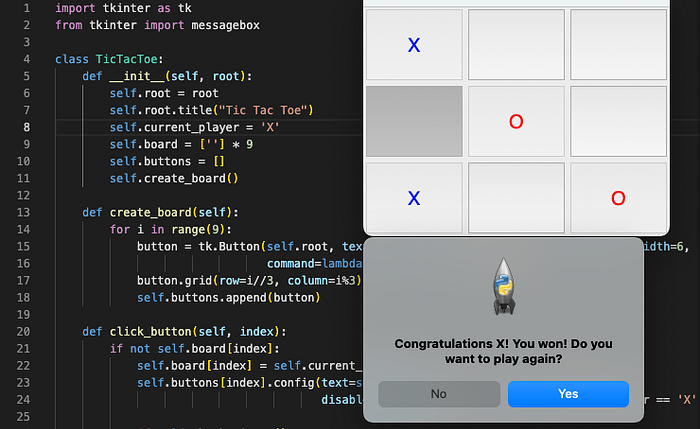Building a Simple Tic-Tac-Toe Game with Python’s Tkinter: A Step-by-Step Tutorial for Beginners

Are you new to Python programming and looking for a hands-on project to enhance your skills? Developing a simple Tic-Tac-Toe game using Python’s tkinter library is an excellent way to learn the basics of GUI (Graphical User Interface) programming. In this step-by-step tutorial, we’ll guide you through the process of building a Tic-Tac-Toe game from scratch. By the end of this post, you'll have a functional game that you can play, customize, and even expand on.
Why Build a Tic-Tac-Toe Game in Python?
Creating a Tic-Tac-Toe game in Python offers several learning opportunities:
- Understanding GUI development: Learn how to create and manage a user interface using
tkinter. - Game logic implementation: Practice managing game states and logic in Python.
- Event handling: Gain experience in handling user interactions and events in a Python application.
Prerequisites for This Python Project
Before we begin, ensure you have Python installed on your system. The tkinter library comes pre-installed with most Python distributions, so you shouldn't need any additional installations. If you don’t have Python installed, you can download it from python.org.
Step 1: Setting Up the Python Environment
To get started, open your favorite Python IDE or text editor, and create a new Python file (e.g., tic_tac_toe.py). Begin by importing the necessary modules:
pip install tkinterimport tkinter as tk
from tkinter import messageboxHere, tkinter is the library we’ll use to create the graphical interface, and messagebox will allow us to display pop-up messages at the end of the game.
Step 2: Creating the Game Class
Next, we’ll define a class called TicTacToe that will contain all the logic and GUI elements for our game:
class TicTacToe:
def __init__(self, root):
self.root = root
self.root.title("Tic Tac Toe")
self.current_player = 'X'
self.board = [''] * 9
self.buttons = []
self.create_board()self.root.title("Tic Tac Toe"): Sets the window title.self.current_player = 'X': Initializes the game with player 'X' starting.self.board = [''] * 9: Creates an empty list representing the game board.
Step 3: Building the Tic-Tac-Toe Board
In this step, we’ll create the 3x3 grid of buttons that will serve as our game board:
def create_board(self):
for i in range(9):
button = tk.Button(self.root, text='', font=('Helvetica', 20), height=3, width=6,
command=lambda i=i: self.click_button(i))
button.grid(row=i//3, column=i%3)
self.buttons.append(button)Each button represents a cell on the Tic-Tac-Toe board. The command parameter links each button to a click event, allowing us to detect when a player selects a cell.
Step 4: Handling User Clicks and Updating the Board
Now, we’ll define the behavior when a player clicks on a button:
def click_button(self, index):
if not self.board[index]:
self.board[index] = self.current_player
self.buttons[index].config(text=self.current_player, state='disabled',
disabledforeground='blue' if self.current_player == 'X' else 'red')
if self.check_winner():
self.show_winner(self.current_player)
elif '' not in self.board:
self.show_draw()
else:
self.current_player = 'O' if self.current_player == 'X' else 'X'Step 5: Implementing Win Conditions
The next step is to define how the game checks if a player has won:
def check_winner(self):
win_conditions = [(0, 1, 2), (3, 4, 5), (6, 7, 8),
(0, 3, 6), (1, 4, 7), (2, 5, 8),
(0, 4, 8), (2, 4, 6)]
for condition in win_conditions:
if self.board[condition[0]] == self.board[condition[1]] == self.board[condition[2]] != '':
return True
return FalseThis method evaluates all possible winning combinations on the board. If one of these combinations is filled with the same player’s symbol, that player wins.
Step 6: Displaying the Game Outcome
Once a player wins or the game ends in a draw, we’ll display a message and ask if the user wants to play again:
def show_winner(self, player):
if messagebox.askyesno("Game Over", f"Congratulations {player}! You won! Do you want to play again?"):
self.reset_board()
else:
self.root.quit()
def show_draw(self):
if messagebox.askyesno("Game Over", "This was a draw! Do you want to play again?"):
self.reset_board()
else:
self.root.quit()These methods utilize messagebox.askyesno to prompt the user with a "Yes" or "No" option. If "Yes" is selected, the game board resets for a new game.
Step 7: Resetting the Board for a New Game
To reset the game, we clear the board and re-enable the buttons:
def reset_board(self):
self.board = [''] * 9
self.current_player = 'X'
for button in self.buttons:
button.config(text='', state='normal')Step 8: Running the Game
Finally, we need to create an instance of the TicTacToe class and start the tkinter main loop:
if __name__ == "__main__":
root = tk.Tk()
game = TicTacToe(root)
root.mainloop()Conclusion
By following this step-by-step guide, you’ve successfully built a simple Tic-Tac-Toe game using Python and tkinter. This project is not only fun but also provides a practical way to understand GUI programming, event handling, and game logic in Python. As you continue learning, consider expanding this game with additional features like a scoreboard or AI opponent. Keep experimenting and happy coding!
